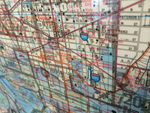The waterfront Albert I Promenade and the Zeedijk are lined by beaches and a casino. There's culture here, too, in notable art museums and links with modern artists. The long beach west of the harbor has stretches that are under lifeguard surveillance in summer from 10:30am to 6:30pm, and some stretches where swimming is not permitted at any time. Look for the signs that indicate both of these, and for the green, yellow, or red flags that tell you whether the sea conditions permit swimming.
Leisure Attractions
Belgium's largest casino, Casino Oostende, Oosthelling (tel. 059/70-51-11; www.cko.be), has gaming rooms for roulette, blackjack, craps, and stud poker, along with slot machines. There's been a casino at this spot since 1852, but the elegant original was unlucky enough to occupy a prime spot for a concrete bunker in Adolf Hitler's Atlantic Wall seacoast defenses -- you might think the 1953 replacement isn't much of an improvement over the bunker. The gaming rooms are open daily (minimum age 21) from 3pm to 7am. Admission is free and a passport or identity card is required.
The Wellington Renbaan (Wellington Racetrack), Koningin Astridlaan 10 (tel. 059/80-60-55), close to the Royal Arcades, is the only racetrack on the seacoast. A post-World War II successor to an 1856 original, it has a grass track for flat and hurdle racing and a lava track for the trotters. Racing takes place in July and August (five races in each month). Admission is 5€ ($8).
Royal Ostend
Made fashionable by King Léopold I's decision to establish a vacation residence here in 1834, Ostend became a magnet for blue-blooded vacationers from Britain and the Continent. Remnants of this vanished glory are scattered around town. The Venetiaanse Gaanderijen (Venetian Galleries; 1903), now an exhibits hall, is on the seafront Albert I Promenade. The 400m-long (1,300-ft.) Koninklijke Gaanderijen (Royal Galleries; 1906) connected the Royal Villa with the racetrack. These galleries protected the royals and their entourage from sun, wind, and rain during promenades. In 1930, the Thermae Palace was constructed at the center of the galleries.
At the entrance to the Venetian Galleries stands a sympathetic bronze sculpture (2000) of King Baudouin (1951-93). The "people's king" is depicted strolling in Ostend, wearing a raincoat. Compared with the resort's haughty sculptures of Léopold I (1831-65) and Léopold II (1865-1909), this shows how times changed for the royal family. Léopold I adopts a heroic nationalistic pose in an equestrian sculpture on Léopold I Plein, and Léopold II a pompous imperialistic pose in an equestrian sculpture on the seafront Zeedijk at the Venetian Galleries.
The summer residence of Léopold I, a surprisingly ordinary-looking townhouse at Langestraat 69, was abandoned by the royals. It now houses the Ostend Historical Museum. Its 1954 waterfront replacement as the Royal Villa later became the plush Oostendse Compagnie Hotel, which closed in 2005, and the building now is privately owned. Léopold II earned a reputation for allowing the royal libido free rein. He supposedly stashed one of his mistresses, a Hungarian baroness, at the grand Villa Maritza, Albert I Promenade 76, one of a group of three surviving 19th-century waterfront villas, and now an upscale restaurant.
The vast, neo-Gothic Sint-Petrus-en Pauluskerk (St. Peter and Paul Church), from 1907, close to the ferry dock, on Sint-Petrus-en-Paulusplein, has a suite of stained-glass windows and a memorial chapel dedicated to Belgium's first queen, Marie-Louise of Orléans, who died in Ostend in 1850.
Marine Themes
There's plenty of sea-related stuff to see and do in Ostend. Kids will likely appreciate a ramble through the Driemaster Mercator (Three-Master Mercator), Mercatordok (tel. 059/70-56-54; www.zeilschip-mercator.be), moored in a dock facing the rail station. Formerly a Belgian merchant marine training ship, the Mercator, a white-painted, three-masted schooner, is now a floating maritime museum. The ship is open May, June, and September daily from 10am to 12:30pm and 2 to 4:30pm, July and August daily from 10am to 5:30pm, and October to April weekends and school vacations from 10am to 12:30pm and 2 to 4:30pm (closed Jan 1 and Dec 25). Admission is 4€ ($6.40) for adults, 3€ ($4.80) for seniors, 2€ ($3.20) for children ages 6 to 14, and free for children 5 and under.
Another worthwhile old sea dog is the Museumschip (Museum Ship) Amandine, Vindictivelaan 35Z (tel. 059/23-43-01; www.museum-amandine.be). Launched in 1961, the trawler was the last Ostend IJslandvaarder (Iceland fishing boat) to work the rich Iceland fishing grounds. She now sits in a dry basin on a plastic "sea," as a museum of the history and traditions of Ostend's Icelandic fishery. The ship can be visited Monday from 2 to 6pm, and Tuesday to Sunday from 10am to 6pm. Admission is 4€ ($6.40) for adults, and 2€ ($3.20) for children 13 and under.
Though popular with children, the small Noordzeeaquarium (North Sea Aquarium), Visserskaai (tel. 059/50-08-76), by the old fishing harbor, is not exactly riveting. It features North Sea flora and fauna, including fish, mollusks, crustaceans, polyps, anemones, and shell and seaweed collections. The aquarium is open April to May daily from 10am to noon and 2 to 5pm, June to September daily from 10am to 12:30pm and 2 to 6pm, and October to March weekends and holidays from 10am to 12:30pm and 2 to 6pm. Admission is 2€ ($3.20) for adults, 1€ ($1.60) for children ages 4 to 14, and free for children 3 and under.
You need to be up early to watch the stands at the Vistrap (Fish Market) on Visserskaai being loaded up with North Sea fish fresh off the boats from the previous night's catch. Sole, plaice, whiting, cod, bream, brill, eels, and shrimps are the main species on view and for sale.
Note: This information was accurate when it was published, but can change without notice. Please be sure to confirm all rates and details directly with the companies in question before planning your trip.








